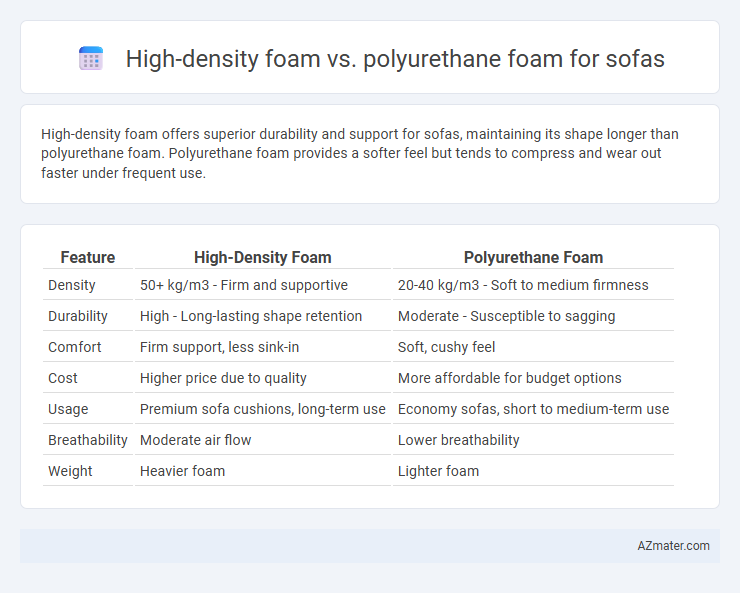High-density foam offers superior durability and support for sofas, maintaining its shape longer than polyurethane foam. Polyurethane foam provides a softer feel but tends to compress and wear out faster under frequent use.
Table of Comparison
| Feature | High-Density Foam | Polyurethane Foam |
|---|---|---|
| Density | 50+ kg/m3 - Firm and supportive | 20-40 kg/m3 - Soft to medium firmness |
| Durability | High - Long-lasting shape retention | Moderate - Susceptible to sagging |
| Comfort | Firm support, less sink-in | Soft, cushy feel |
| Cost | Higher price due to quality | More affordable for budget options |
| Usage | Premium sofa cushions, long-term use | Economy sofas, short to medium-term use |
| Breathability | Moderate air flow | Lower breathability |
| Weight | Heavier foam | Lighter foam |
Understanding High-Density Foam
High-density foam offers superior durability and support for sofa cushions, maintaining shape longer than standard polyurethane foam, which tends to compress faster. This type of foam typically has a density higher than 1.8 pounds per cubic foot, ensuring resilience and comfort in seating applications. High-density foam's ability to resist wear and retain firmness makes it ideal for high-traffic areas and long-term use in upholstered furniture.
Overview of Polyurethane Foam
Polyurethane foam is a widely used material in sofa cushions due to its versatility, affordability, and comfort. It offers a range of densities and firmness levels, making it suitable for various seating preferences and support needs. High-density polyurethane foam provides enhanced durability and better shape retention compared to lower-density options, making it a popular choice for long-lasting sofa cushions.
Key Differences Between High-Density and Polyurethane Foam
High-density foam offers superior durability and support for sofas due to its increased density of 1.8 pounds per cubic foot or higher, making it ideal for long-term comfort and shape retention. Polyurethane foam, commonly available with densities ranging from 1.2 to 1.8 pounds per cubic foot, provides a softer feel and is more affordable but tends to wear out faster and lose firmness over time. The key differences lie in their density, longevity, and firmness, with high-density foam preferred for premium, lasting upholstery and polyurethane foam suited for budget-friendly or occasional-use furniture.
Comfort and Support Comparison
High-density foam offers superior durability and firm support, maintaining its shape over time and providing consistent comfort for prolonged seating. Polyurethane foam, while softer and more affordable, tends to compress faster and loses resilience, which can reduce long-term support and comfort. Choosing high-density foam for sofas ensures better posture alignment and enhances overall seating experience due to its enhanced structural integrity and longevity.
Durability and Longevity
High-density foam offers superior durability and longer lifespan compared to standard polyurethane foam, making it ideal for sofa cushions that withstand daily use without sagging. The denser composition resists deformation, maintaining support and comfort over time, whereas polyurethane foam tends to compress and lose resilience more quickly. Investing in high-density foam enhances the sofa's structural integrity, providing extended comfort and sustained shape retention.
Cost Considerations
High-density foam typically costs more than polyurethane foam due to its superior durability and support, which makes it a popular choice for long-lasting sofa cushions. Polyurethane foam offers a budget-friendly option with moderate comfort and lifespan, making it suitable for cost-conscious buyers or temporary furniture. When evaluating cost considerations, factoring in the long-term value of high-density foam can justify the initial higher investment by reducing the frequency of replacement or repairs.
Maintenance and Care
High-density foam for sofas offers superior durability and maintains its shape longer than polyurethane foam, reducing the need for frequent replacement or repairs. Polyurethane foam tends to absorb moisture and degrade faster if not properly cared for, requiring regular cleaning and protective measures to prevent wear. Maintaining high-density foam involves occasional fluffing and vacuuming to preserve its structure, while polyurethane foam demands more careful maintenance to avoid sagging and material breakdown.
Suitability for Various Sofa Styles
High-density foam offers superior support and durability, making it ideal for modern and minimalist sofa styles that emphasize clean lines and firm seating. Polyurethane foam provides a softer, more cushioned feel, suitable for traditional and casual sofas where comfort and plushness are prioritized. Choosing between high-density and polyurethane foam depends on the desired sofa style and the balance between support and softness.
Environmental Impact and Safety
High-density foam typically contains fewer volatile organic compounds (VOCs) and has a longer lifespan, reducing waste compared to polyurethane foam, which may emit higher levels of VOCs impacting indoor air quality. Polyurethane foam often involves petrochemical-based components that contribute to environmental pollution and are less biodegradable than natural or plant-based high-density foam alternatives. Choosing CertiPUR-US certified high-density foam ensures compliance with strict emissions standards and safety regulations, promoting a healthier indoor environment and reduced ecological footprint.
Making the Right Choice for Your Sofa
High-density foam offers superior durability and support for sofas, maintaining shape and comfort over time compared to polyurethane foam, which is softer but tends to compress and wear faster. Choosing the right foam depends on your priorities: opt for high-density foam if you need long-lasting firmness and resilience, or select polyurethane foam for a plush, budget-friendly option. Consider factors like daily use, weight support, and budget to ensure your sofa provides comfort and longevity tailored to your lifestyle.

Infographic: High-density foam vs Polyurethane foam for Sofa
 azmater.com
azmater.com